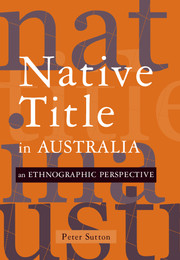Book contents
- Frontmatter
- Contents
- List of Figures
- Acknowledgements
- Introduction
- Map
- Chapter 1 Kinds of Rights in Country
- Chapter 2 Local Organisation Before the Land Claims Era
- Chapter 3 Aboriginal Country Groups
- Chapter 4 Atomism versus Collectivism
- Chapter 5 Underlying and Proximate Customary Titles
- Chapter 6 The System Question
- Chapter 7 Kinship, Filiation and Aboriginal Land Tenure
- Chapter 8 Families of Polity
- Notes
- References
- Index
Chapter 3 - Aboriginal Country Groups
Published online by Cambridge University Press: 22 September 2009
- Frontmatter
- Contents
- List of Figures
- Acknowledgements
- Introduction
- Map
- Chapter 1 Kinds of Rights in Country
- Chapter 2 Local Organisation Before the Land Claims Era
- Chapter 3 Aboriginal Country Groups
- Chapter 4 Atomism versus Collectivism
- Chapter 5 Underlying and Proximate Customary Titles
- Chapter 6 The System Question
- Chapter 7 Kinship, Filiation and Aboriginal Land Tenure
- Chapter 8 Families of Polity
- Notes
- References
- Index
Summary
INDIGENOUS COUNTRY GROUPS AND THE COMMUNITY OF NATIVE TITLE HOLDERS
Proving Native Title involves, among other things, a process of cultural translation. An indigenous person or group, usually on behalf of other persons and groups as well as themselves, makes application to have their customary rights and interests in an area of land and waters, as held by the group, recognised in the form of a determination in accordance with the Native Title Act. Most determination applications are on behalf of a set of people delimited along the lines of a collective identity such as a language group or a set of smaller identity groups such as descent-based or other groups with particular interests in different parts of the area concerned, or all of it together.
In the case of Ward, for example, the trial judge, Justice Lee, found that native title existed in the determination area, and it was held by the Miriuwung and Gajerrong people (the first applicants), and in respect of that part of the determination area known as Boorroonong (Lacrosse Island) native title was held by the Balangarra people (the third applicants). The second applicants sought to establish a determination of native title for three ‘estate groups’ (Dumbral, Nyawanyawam and Binjen) of the Miriuwung ‘community’, but instead the judge found that the native title that existed in the determination area was a communal title held collectively by members of the Miriuwung and Gajerrong ‘community’. These are significant indigenous groupings.
- Type
- Chapter
- Information
- Native Title in AustraliaAn Ethnographic Perspective, pp. 54 - 84Publisher: Cambridge University PressPrint publication year: 2003

